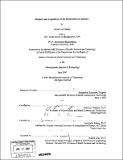| dc.contributor.advisor | Anthony J. Sinskey and Antoinette Schoar. | en_US |
| dc.contributor.author | Ohashi, Kevin Lee | en_US |
| dc.contributor.other | Harvard University--MIT Division of Health Sciences and Technology. | en_US |
| dc.date.accessioned | 2007-11-16T14:27:40Z | |
| dc.date.available | 2007-11-16T14:27:40Z | |
| dc.date.copyright | 2007 | en_US |
| dc.date.issued | 2007 | en_US |
| dc.identifier.uri | http://hdl.handle.net/1721.1/39576 | |
| dc.description | Thesis (S.M.)--Harvard-MIT Division of Health Sciences and Technology, 2007. | en_US |
| dc.description | Includes bibliographical references (leaves 84-85). | en_US |
| dc.description.abstract | Mergers and acquisitions in the Medical Device Industry are the primary mode of exit for early stage companies. The focus of this thesis is to examine factors which influence the value of these M&A transactions from the target and acquiring firm perspectives and to understand the value creation that occurs. Publicly available electronic and published data sources were used to build a database of 674 M&A transactions and 113 IPO events for deals with published deal values and terms between January 1996 and October 2006. In this work, we demonstrate that transaction deal value varies between various medical device industry sectors. Factors that were shown to significantly correlate with M&A transaction deal value included the Sales of the target company, Market Capitalization value of the acquiring company, type of regulatory approval, and whether the company had venture backing prior to acquisition. M&A transactions that involved targets that were Public companies had significantly higher deal values than those that were private. Using 3-day event window analysis, returns of acquiring companies were shown to be slightly negative and significantly less than the S&P composite index returns over the same period. | en_US |
| dc.description.abstract | (cont.) Previous studies suggest that managers in larger firms tend to use overvalued stock and empire building behavior, resulting in overbidding or pay more for acquisitions. No significant difference in deal value was associated with financing terms between cash and stock transactions. The use of earn outs had no effect on the deal value or the acquirer stock returns. Markets that are developing will continue to have increasing deal value as firms attempt to establish market share and or acquire breakthrough technologies. We found that there were positive correlation of M&A or IPO transaction value for companies in less mature markets where companies have opportunities to leap frog other companies in market position and share. Conversely, there is negative correlation of M&A or IPO transaction value for companies in more mature markets. The results are discussed in terms of the specific factors that influence the transaction value and the degree to which target and acquiring firms benefit from M&A transactions. | en_US |
| dc.description.statementofresponsibility | by Kevin Lee Ohashi. | en_US |
| dc.format.extent | 100 leaves | en_US |
| dc.language.iso | eng | en_US |
| dc.publisher | Massachusetts Institute of Technology | en_US |
| dc.rights | M.I.T. theses are protected by copyright. They may be viewed from this source for any purpose, but reproduction or distribution in any format is prohibited without written permission. See provided URL for inquiries about permission. | en_US |
| dc.rights.uri | http://dspace.mit.edu/handle/1721.1/7582 | |
| dc.subject | Harvard University--MIT Division of Health Sciences and Technology. | en_US |
| dc.title | Mergers and acquisitions in the medical device industry | en_US |
| dc.type | Thesis | en_US |
| dc.description.degree | S.M. | en_US |
| dc.contributor.department | Harvard University--MIT Division of Health Sciences and Technology | |
| dc.identifier.oclc | 174282482 | en_US |
